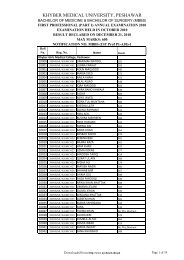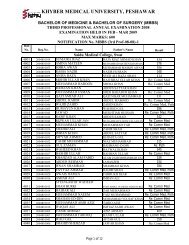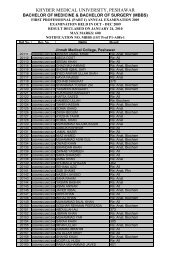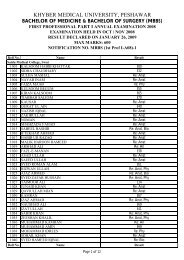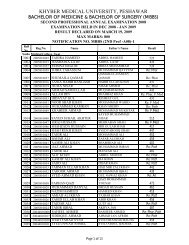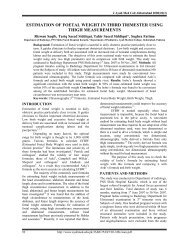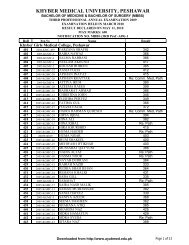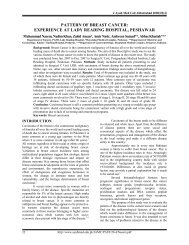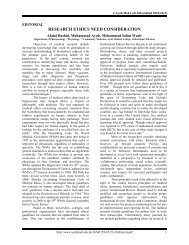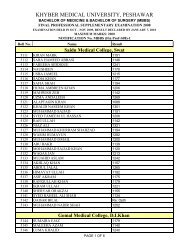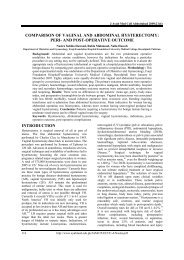incidence of endometrial hyperplasia in 100 cases presenting
incidence of endometrial hyperplasia in 100 cases presenting
incidence of endometrial hyperplasia in 100 cases presenting
Create successful ePaper yourself
Turn your PDF publications into a flip-book with our unique Google optimized e-Paper software.
J Ayub Med Coll Abbottabad 2009;21(2)<br />
INCIDENCE OF ENDOMETRIAL HYPERPLASIA IN <strong>100</strong> CASES<br />
PRESENTING WITH POLYMENORRHAGIA/MENORRHAGIA IN<br />
PERIMENUPAUSAL WOMEN<br />
Amera Takreem, Nargis Danish*, Sadia Razaq*<br />
Department <strong>of</strong> Obstetrics & Gynaecology, Saidu Medical College, Swat, *Department <strong>of</strong> Obstetrics & Gynaecology, Women Medical<br />
College, Abbottabad, Pakistan<br />
Background: To study the Incidence <strong>of</strong> <strong>endometrial</strong> <strong>hyperplasia</strong> <strong>in</strong> perimenupausal women present<strong>in</strong>g<br />
with polymenorrhagia/menorrhagia. This observational study was conducted at Gynae ‘B’ unit <strong>of</strong><br />
Khyber Teach<strong>in</strong>g Hospital Peshawar from January 2000 to December 2001. Methods: One hundred<br />
consecutive patients who presented at Gynaecology OPD with Polymenorrhagia/ Menorrhagia were<br />
registered and <strong><strong>in</strong>cidence</strong> <strong>of</strong> <strong>endometrial</strong> <strong>hyperplasia</strong> evaluated <strong>in</strong> them. All women were above 45 years<br />
<strong>of</strong> age. Post-menopausal bleed<strong>in</strong>g <strong>cases</strong> were excluded from the study. Results: Out <strong>of</strong> <strong>100</strong> patients, 15<br />
patients were found to have <strong>endometrial</strong> <strong>hyperplasia</strong>, 10 patients (66.6%) simple cystic <strong>hyperplasia</strong>, 3<br />
patients (20.0%) had adenomotous <strong>hyperplasia</strong>, 2 patients (13.3%) had atypical <strong>hyperplasia</strong>, 8 patients<br />
(53.3%) with menorrhagia, 1 (6.6%) with polymenorrhagia, and 6 patients (40.0%) with<br />
polymenorrhoea. Duration <strong>of</strong> symptoms was from 4 months to 1 year. Thirteen (86.6%) patients were<br />
treated medically, 5 patients (33.33%) needed surgical treatment follow<strong>in</strong>g medical treatment, 2<br />
patients (13.3%) underwent Total Abdom<strong>in</strong>al Hysterectomy (TAH) and Bilateral Salp<strong>in</strong>gooophorectomy<br />
(BSO) who were 51–53 years <strong>of</strong> age with atypical <strong>hyperplasia</strong>. Conclusion:<br />
<strong>endometrial</strong> <strong>hyperplasia</strong> is a pre-malignant condition; if treated <strong>in</strong> time, <strong><strong>in</strong>cidence</strong> can be reduced and<br />
early treatment can <strong>in</strong>crease life expectancy and quality <strong>in</strong> women over age <strong>of</strong> 45 years.<br />
Keyword: Menorrhagia, Polymenorrhagia, Endometrial <strong>hyperplasia</strong>, Transvag<strong>in</strong>al Ultrasound, TVS<br />
INTRODUCTION<br />
Hyperplasia is the <strong>in</strong>crease <strong>in</strong> size <strong>of</strong> an organ or tissue<br />
due to <strong>in</strong>crease <strong>in</strong> no. <strong>of</strong> its specialized cells.<br />
Endometrium is capable <strong>of</strong> marked <strong>hyperplasia</strong> as a<br />
response to stimulus <strong>of</strong> prolonged and unopposed<br />
oestrogen classification <strong>of</strong> <strong>endometrial</strong> <strong>hyperplasia</strong>. 1<br />
Simple or cystic <strong>hyperplasia</strong> is a benign proliferation <strong>of</strong><br />
<strong>endometrial</strong> glands that are irregular and dilated but do<br />
not display back to back crowd<strong>in</strong>g or cellular atypia.<br />
Complex adenomatous <strong>hyperplasia</strong> is a proliferation <strong>of</strong><br />
<strong>endometrial</strong> glands with irregular outl<strong>in</strong>e architectural<br />
complexity and back to back crowd<strong>in</strong>g but no atypia.<br />
Atypical <strong>hyperplasia</strong> is a vary<strong>in</strong>g degrees <strong>of</strong><br />
nuclear atypia and loss <strong>of</strong> polarity fond <strong>in</strong> both simple<br />
and complex hyperplastic lesion. Incidence <strong>of</strong><br />
<strong>hyperplasia</strong> <strong>in</strong> a study by Wentz 2 <strong>in</strong> curettage specimen<br />
was:<br />
Cystic <strong>hyperplasia</strong> 5.1%<br />
Adenomatous <strong>hyperplasia</strong> 2.6%<br />
Atypical <strong>hyperplasia</strong> 1.3%<br />
Endometrial <strong>hyperplasia</strong> is a precursor <strong>of</strong><br />
<strong>endometrial</strong> carc<strong>in</strong>oma, the most common malignancy<br />
<strong>of</strong> female reproductive tract. It accounts for 6% <strong>of</strong> new<br />
female <strong>cases</strong> and 3% <strong>of</strong> female cancer deaths. 1 Besides<br />
<strong>endometrial</strong> <strong>hyperplasia</strong> prom<strong>in</strong>ent risk factors for<br />
<strong>endometrial</strong> carc<strong>in</strong>oma are unopposed oestrogen<br />
therapy, obesity, diabetes early menarche and late<br />
menopause. 2<br />
The 3 grades <strong>of</strong> <strong>endometrial</strong> <strong>hyperplasia</strong> are<br />
simple (cystic), adenomatous (complex) and atypical<br />
<strong>hyperplasia</strong>. Endometrial <strong>hyperplasia</strong> <strong>in</strong> most <strong>of</strong> the<br />
<strong>cases</strong> is idiopathic. It may be due to anovulation at<br />
extreme <strong>of</strong> age. 3<br />
The role <strong>of</strong> exogenous oestrogen <strong>in</strong> <strong>in</strong>duc<strong>in</strong>g<br />
<strong>endometrial</strong> <strong>hyperplasia</strong> <strong>in</strong> a well-known recent<br />
prospective study showed that 10% <strong>of</strong> women<br />
developed adenomatous <strong>hyperplasia</strong> every year.<br />
Tamoxifen used for breast cancer, due to its weak<br />
oestrogenic effect can <strong>in</strong>duce <strong>endometrial</strong> <strong>hyperplasia</strong>.<br />
Niwa et al 4 conducted a study on mice to see the effects<br />
<strong>of</strong> Tamoxifen on endometrium. The results showed<br />
<strong>in</strong>creased <strong><strong>in</strong>cidence</strong> <strong>of</strong> pre-neoplastic lesions <strong>of</strong> the<br />
endometrium. Oestrogen secret<strong>in</strong>g ovarian tumours,<br />
may be the occasional cause <strong>of</strong> <strong>endometrial</strong><br />
<strong>hyperplasia</strong>. 5<br />
Cl<strong>in</strong>ical presentation at perimenopausal age is<br />
usually abnormal uter<strong>in</strong>e bleed<strong>in</strong>g. The three<br />
pathological types <strong>of</strong> <strong>endometrial</strong> <strong>hyperplasia</strong> are simple<br />
<strong>in</strong> which there is cystic dilatation <strong>of</strong> glands;<br />
adenomatous <strong>hyperplasia</strong> when glands have very<br />
irregular outl<strong>in</strong>e show<strong>in</strong>g marked structural complexity;<br />
and atypical <strong>hyperplasia</strong> is characterised by glands<br />
show<strong>in</strong>g nuclear atypia with abnormal mitotic figures.<br />
Association with concomitant <strong>endometrial</strong> cancer,<br />
ovarian cancer, and progression <strong>of</strong> <strong>hyperplasia</strong> to cancer<br />
should be kept <strong>in</strong> m<strong>in</strong>d while deal<strong>in</strong>g with these<br />
patients.<br />
In atypical <strong>hyperplasia</strong>, co-existent carc<strong>in</strong>omas<br />
range from 25 to 50%. 6 The risk <strong>of</strong> progression to<br />
<strong>endometrial</strong> cancer ranges from 22.6 to 88.9%. 7<br />
Malignant transformation occurs <strong>in</strong> 15%, 24%,<br />
and 45% <strong>of</strong> mild moderate and sever atypical<br />
60<br />
http://www.ayubmed.edu.pk/JAMC/PAST/21-2/Amera.pdf
J Ayub Med Coll Abbottabad 2009;21(2)<br />
<strong>hyperplasia</strong> respectively. 8 Certa<strong>in</strong> animal data support<br />
the hypothesis that oestrogen can be carc<strong>in</strong>ogenic for<br />
endometrium but human data are less certa<strong>in</strong>. The best<br />
representation <strong>of</strong> these are based on data by Sommers 9<br />
which illustrate <strong>endometrial</strong> polyps progress<strong>in</strong>g to cystic<br />
<strong>hyperplasia</strong> and then to adenomatous under the<br />
<strong>in</strong>fluence <strong>of</strong> oestrogen.<br />
PATIENTS AND METHODS<br />
Study was conducted from January 2000 to December<br />
2001. One hundred patients <strong>of</strong> more than 45 years age<br />
present<strong>in</strong>g with Menorrhagia/ Polymenorrhagia were<br />
studied. Postmenopausal bleed<strong>in</strong>g <strong>cases</strong> were excluded<br />
from the study.<br />
All patients were seen <strong>in</strong> out door cl<strong>in</strong>ic. A<br />
detailed history was taken. Inquiry about bleed<strong>in</strong>g<br />
disorder, liver and thyroid dysfunction was also made<br />
to exclude these causes <strong>of</strong> menorrhagia. Drug history<br />
especially <strong>of</strong> oestrogen and Tamoxifen was taken and<br />
none was found us<strong>in</strong>g these drugs. There was no<br />
family history <strong>of</strong> ovarian or <strong>endometrial</strong> carc<strong>in</strong>oma <strong>in</strong><br />
all patients.<br />
After tak<strong>in</strong>g history, patients were exam<strong>in</strong>ed<br />
thoroughly. Exam<strong>in</strong>ation <strong>in</strong>cluded general physical,<br />
systemic and pelvic exam<strong>in</strong>ation. Per rectum<br />
exam<strong>in</strong>ation was done <strong>in</strong> all patients. Rout<strong>in</strong>e<br />
<strong>in</strong>vestigations <strong>in</strong>clud<strong>in</strong>g blood group and Rh-factor,<br />
random blood sugar, ur<strong>in</strong>e rout<strong>in</strong>e analysis and special<br />
<strong>in</strong>vestigation, transvag<strong>in</strong>al ultrasound (TVS) was done<br />
to see for <strong>endometrial</strong> thickness and ovarian<br />
enlargement. Diagnostic curettage preferably <strong>in</strong> the<br />
second half <strong>of</strong> the cycle was done and histopathology<br />
<strong>of</strong> the specimens done.<br />
RESULTS<br />
Age <strong>of</strong> the patients ranged from 45–53 years (Table-1).<br />
All patients with adenomatous and atypical<br />
<strong>hyperplasia</strong> were hav<strong>in</strong>g irregular periods show<strong>in</strong>g the<br />
severity <strong>of</strong> disease. Pattern <strong>of</strong> bleed<strong>in</strong>g <strong>in</strong> patients<br />
hav<strong>in</strong>g cystic <strong>endometrial</strong> <strong>hyperplasia</strong> was ma<strong>in</strong>ly<br />
Menorrhagia/polymenorrhagia (Table-2).<br />
Duration <strong>of</strong> symptoms were from 4 months to<br />
1 year. Cystic <strong>hyperplasia</strong> found to be the commonest<br />
<strong>of</strong> all. Endometrial thicken<strong>in</strong>g was significant <strong>in</strong><br />
diagnosis <strong>of</strong> <strong>endometrial</strong> <strong>hyperplasia</strong>. (Table-3).<br />
Ten (66.6%) patients had <strong>endometrial</strong><br />
thickness more then 10 mm (Table-5). Hypertension<br />
and diabetes, were found common <strong>in</strong> patients hav<strong>in</strong>g<br />
adenomatous <strong>hyperplasia</strong> (Table-6). Medical treatment<br />
was also found effective <strong>in</strong> patients hav<strong>in</strong>g simple or<br />
cystic <strong>hyperplasia</strong>. Medical followed by surgical<br />
treatment was needed <strong>in</strong> a few patients while direct<br />
TAH+BSO was done <strong>in</strong> patients above the age <strong>of</strong> 51<br />
years (Table-7).<br />
Table-1: Age groups <strong>of</strong> the patients hav<strong>in</strong>g<br />
<strong>endometrial</strong> <strong>hyperplasia</strong> (n=15)<br />
Age Groups Number Percentage<br />
45–48 years 10 66.66<br />
49–50 years 3 20.0<br />
51–53 years 2 13.3<br />
Table-2: Pattern <strong>of</strong> bleed<strong>in</strong>g <strong>in</strong> patients hav<strong>in</strong>g<br />
<strong>endometrial</strong> <strong>hyperplasia</strong> (n=15)<br />
Pattern <strong>of</strong> Bleed<strong>in</strong>g Number Percentage<br />
Menorrhagia 8 53.33<br />
Polymenorrhagia 1 6.6<br />
Polymenorrhoea 6 40.0<br />
Table-3: Duration <strong>of</strong> symptoms (n=15)<br />
Duration <strong>of</strong> Symptoms Number Percentage<br />
4 – 8 months 10 66.6<br />
8 – 12 months 4 26.6<br />
> 1 years 1 6.6<br />
Table–4: Type <strong>of</strong> <strong>endometrial</strong> <strong>hyperplasia</strong><br />
Number Percentage<br />
Cystic Hyperplasia 10 66.6<br />
Adenomatous Hyperplasia 3 20.0<br />
Atypical Hyperplasia 2 13.33<br />
Table-5: Endometrial thickness on transvag<strong>in</strong>al<br />
ultrasound<br />
Number Percentage<br />
5 – 6 mm 2 13.33<br />
7 – 8 mm 3 20.0<br />
> 10 mm 10 66.66<br />
Table-6: Associated disease with <strong>endometrial</strong><br />
hyperplasisa<br />
Number Percentage<br />
Hypertension 3 20<br />
Diabetes 2 13.3<br />
Thyroid disease 0 0<br />
Liver disorder 0 0<br />
Table-7: Type <strong>of</strong> management<br />
Treatment Number Percentage<br />
Medical 13 86.6<br />
Medical followed by surgical 5 33.33<br />
Direct surgical 2 13.3<br />
DISCUSSION<br />
Endometrial <strong>hyperplasia</strong> is common <strong>in</strong> perimenopausal<br />
women caus<strong>in</strong>g symptoms <strong>of</strong> irregular or prolonged<br />
bleed<strong>in</strong>g due to anovulatory cycles <strong>in</strong> majority <strong>of</strong> <strong>cases</strong>.<br />
Heavy bleed<strong>in</strong>g is secondary to susta<strong>in</strong>ed level <strong>of</strong><br />
oestrogens. The overgrowth not only affects glands and<br />
stroma but there is also abnormal vascularisation.<br />
Bleed<strong>in</strong>g is prolong and excessive because <strong>of</strong> massive<br />
tissue available for bleed<strong>in</strong>g and random break down <strong>of</strong><br />
tissue result<strong>in</strong>g <strong>in</strong> exposure <strong>of</strong> vascular channels. There<br />
is no vasoconstrictive rhythmicity, no tight coil<strong>in</strong>g <strong>of</strong><br />
spiral vessels and no collapse to <strong>in</strong>duce stasis. The<br />
heal<strong>in</strong>g effect <strong>of</strong> oestrogen is brief and vicious cycle <strong>of</strong><br />
bleed<strong>in</strong>g reoccurs. In a study by Horbelt et al 10 ultra<br />
structure <strong>of</strong> microvasculature <strong>in</strong> human endometrium<br />
was studied. Their results showed microvasculature with<br />
http://www.ayubmed.edu.pk/JAMC/PAST/21-2/Amera.pdf 61
J Ayub Med Coll Abbottabad 2009;21(2)<br />
morphologic disorder with altered, extracellular matrix<br />
and wide spread cell death. For detection <strong>of</strong> complex<br />
<strong>hyperplasia</strong> or lesion beyond it <strong>in</strong> <strong>endometrial</strong> cytology<br />
it is important to observe for papillary clusters.<br />
Naheed Moghal 11 performed diagnostic<br />
curettage <strong>in</strong> <strong>cases</strong> present<strong>in</strong>g with abnormal uter<strong>in</strong>e<br />
bleed<strong>in</strong>g. Out <strong>of</strong> 114 patients with <strong>in</strong>tra uter<strong>in</strong>e<br />
abnormal uter<strong>in</strong>e pathology, 51 patients were hav<strong>in</strong>g<br />
<strong>endometrial</strong> <strong>hyperplasia</strong>. Forty-two patients hav<strong>in</strong>g<br />
simple or adenomatous and 7 atypical <strong>hyperplasia</strong>,<br />
majority <strong>of</strong> the patients were <strong>in</strong> age group 41–50 years.<br />
Fayaz S 12 has studied causes <strong>of</strong> Gynaecological<br />
hysterectomies and <strong>in</strong> her study <strong><strong>in</strong>cidence</strong> <strong>of</strong><br />
<strong>endometrial</strong> <strong>hyperplasia</strong> was 4.68%. Jalil R 13 correlated<br />
the <strong>in</strong>dications <strong>of</strong> abdom<strong>in</strong>al hysterectomy with<br />
histopahological f<strong>in</strong>d<strong>in</strong>gs <strong>in</strong> her reports preoperative<br />
diagnosis, by D&C <strong>of</strong> <strong>endometrial</strong> <strong>hyperplasia</strong> was<br />
14.42%. Fouzia Adil 14 conducted a 2 years study and<br />
performed D&C <strong>in</strong> excessive and abnormal uter<strong>in</strong>e<br />
bleed<strong>in</strong>g. Incidence <strong>of</strong> cystic <strong>hyperplasia</strong>, was 32.8%<br />
and adenomatous <strong>hyperplasia</strong> was 8.8%. In our study,<br />
the commonest among <strong>endometrial</strong> <strong>hyperplasia</strong> was<br />
cystic <strong>hyperplasia</strong> (66.6%).<br />
In most <strong>of</strong> the patients with cystic <strong>hyperplasia</strong><br />
bleed<strong>in</strong>g is heavy but cycle is regular, while the pattern<br />
<strong>of</strong> bleed<strong>in</strong>g is irregular <strong>in</strong> complex and atypical<br />
<strong>hyperplasia</strong> show<strong>in</strong>g the severity <strong>of</strong> disease. In our<br />
study, 80% <strong>of</strong> patients with cystic <strong>hyperplasia</strong> had<br />
menorrhagia only.<br />
In most <strong>of</strong> the patients with cystic <strong>hyperplasia</strong><br />
the condition resolves with<strong>in</strong> short period <strong>of</strong> time. In our<br />
study 69.2% resolved while 30.8% persisted as such<br />
after repeat D&C at 12 weeks <strong>in</strong>terval. Progression <strong>of</strong><br />
pathology was not seen <strong>in</strong> any case. In a study by<br />
Terakawa et al 15 51 patients with <strong>endometrial</strong><br />
<strong>hyperplasia</strong> were followed for 6 months, with repeated<br />
<strong>endometrial</strong> biopsy monthly for 3 months and at the end<br />
<strong>of</strong> 6 months. In 69% histology became normal. Their<br />
f<strong>in</strong>d<strong>in</strong>gs are consistent with our study. Terakawa et al<br />
found the lesion to persist <strong>in</strong> 17% <strong>of</strong> simple, 25%<br />
complex, 80% with complex atypical <strong>in</strong> 17% <strong>of</strong> simple,<br />
25% complex, 80% with complex atypical. In our study<br />
lesion persisted <strong>in</strong> 20% <strong>of</strong> cystic <strong>hyperplasia</strong> <strong>cases</strong> and<br />
<strong>in</strong> 333.3% <strong>in</strong> complex <strong>hyperplasia</strong>. Terakawa et al<br />
observed that <strong>in</strong> 3 patients with cystic <strong>hyperplasia</strong> lesion<br />
progressed to atypical <strong>hyperplasia</strong> by the end <strong>of</strong> follow<br />
up. In our study no one progressed.<br />
Endometrial thickness had no particular value<br />
regard<strong>in</strong>g diagnosis <strong>of</strong> <strong>endometrial</strong> <strong>hyperplasia</strong> as 2<br />
patients out <strong>of</strong> 15 were hav<strong>in</strong>g <strong>endometrial</strong> thickness 5–<br />
6 mm. A study performed by Bakos 17 showed that<br />
transvag<strong>in</strong>al ultrasound is as effective as D&C <strong>in</strong><br />
women with irregular bleed<strong>in</strong>g. Doppler endovag<strong>in</strong>al<br />
ultrasonography could detect 76% <strong>of</strong> <strong>endometrial</strong><br />
abnormalities. 18 Although hysteroscopy has<br />
revolutionised the management <strong>of</strong> Dysfunctional<br />
Uter<strong>in</strong>e Bleed<strong>in</strong>g (DUB), D&C rema<strong>in</strong>s the ‘gold<br />
standard’. Perhaps hysteroscopy could be diagnostic aid<br />
to D&C rather than a complete replacement. Dilatation<br />
and Curettage is a day care procedure, easy, cheep, and<br />
no special personnel are required although it needs a<br />
senior person for proper assessment. Hysteroscopy<br />
cannot properly differentiate between various types <strong>of</strong><br />
<strong>endometrial</strong> <strong>hyperplasia</strong>. The hysteroscopist should<br />
always proceed under assumption that every <strong>hyperplasia</strong><br />
can harbour deep foci <strong>of</strong> atypical <strong>hyperplasia</strong> or early<br />
<strong>in</strong>vasive carc<strong>in</strong>oma Ben Yehuda et al. 19 Three hundred<br />
and seventy-three patients between 1991–1995 were<br />
<strong>in</strong>cluded <strong>in</strong> his study. In 61 patients hav<strong>in</strong>g <strong>endometrial</strong><br />
<strong>hyperplasia</strong> by diagnostic D&C the hysteroscopic<br />
impression <strong>of</strong> <strong>hyperplasia</strong> was <strong>in</strong> only 32 patients<br />
<strong>in</strong>dicat<strong>in</strong>g that hysteroscopy did not improve upon the<br />
sensitivity <strong>of</strong> D&C <strong>in</strong> detect<strong>in</strong>g <strong>endometrial</strong> <strong>hyperplasia</strong>.<br />
Ho et al 20 conducted a study from Jan 1991–<br />
Dec 1994. Twenty-n<strong>in</strong>e patients <strong>in</strong> their study had<br />
<strong>endometrial</strong> <strong>hyperplasia</strong> with atypia and 87 were<br />
without atypia. Incidence <strong>of</strong> <strong>endometrial</strong> carc<strong>in</strong>oma was<br />
27.6% <strong>in</strong> those with atypia and 3.4% <strong>in</strong> those without<br />
atypia. Gucer et al 21 studies surgical specimen <strong>of</strong> 214<br />
patients, operated for <strong>endometrial</strong> cancer 43% had<br />
concomitant <strong>endometrial</strong> <strong>hyperplasia</strong>. In our study, no<br />
patient had concomitant <strong>endometrial</strong> carc<strong>in</strong>oma,<br />
probably due to less number <strong>of</strong> patients <strong>in</strong> the study.<br />
When <strong>endometrial</strong> <strong>hyperplasia</strong> is diagnosed<br />
the women should be <strong>in</strong>vestigated for <strong>endometrial</strong> or<br />
ovarian cancer, and to look for any endogenous source<br />
<strong>of</strong> oestrogen, <strong>in</strong>vestigations should <strong>in</strong>clude hysteroscopy<br />
to see <strong>endometrial</strong> and endocervical cavities.<br />
Management options are to stop exogenous<br />
and remove oestrogen produc<strong>in</strong>g ovarian tumour if<br />
found. Medical and surgical treatment depends upon the<br />
severity <strong>of</strong> pathological condition, and the patient’s age<br />
and her wishes for further children.<br />
Short-term use <strong>of</strong> Gonadotroph<strong>in</strong> releas<strong>in</strong>g<br />
hormone analogue is be<strong>in</strong>g <strong>in</strong> use for <strong>endometrial</strong><br />
<strong>hyperplasia</strong>. Colacurci et al 22 used short-term (3<br />
months) therapy with Gonadotroph<strong>in</strong> releas<strong>in</strong>g hormone<br />
analogue to premenopausal women. They showed long,<br />
symptoms free period, and low <strong><strong>in</strong>cidence</strong> <strong>of</strong> side effects.<br />
Six published <strong>cases</strong> were collected by<br />
Gimpelson 23 to establish a l<strong>in</strong>k between the development<br />
<strong>of</strong> <strong>endometrial</strong> cancer and <strong>endometrial</strong> ablation. That<br />
study observed that pre-exist<strong>in</strong>g <strong>endometrial</strong> <strong>hyperplasia</strong><br />
is a common cause <strong>of</strong> <strong>endometrial</strong> carc<strong>in</strong>oma.<br />
Endometrial ablation which could cure DUB is not an<br />
ideal management for <strong>endometrial</strong> <strong>hyperplasia</strong> rather a<br />
contra<strong>in</strong>dication.<br />
CONCLUSION<br />
The commonest cause <strong>of</strong> DUB at perimenopause is<br />
anovulatory cycles. Among <strong>endometrial</strong> <strong>hyperplasia</strong>s,<br />
cystic <strong>hyperplasia</strong> is the commonest. Transvag<strong>in</strong>al<br />
62<br />
http://www.ayubmed.edu.pk/JAMC/PAST/21-2/Amera.pdf
J Ayub Med Coll Abbottabad 2009;21(2)<br />
sonography is not very helpful <strong>in</strong> diagnosis <strong>of</strong><br />
<strong>endometrial</strong> <strong>hyperplasia</strong> and D&C still rema<strong>in</strong>s the<br />
‘gold standard’ for its diagnosis.<br />
REFERENCES<br />
1. Kurman RJ, Kamiriski PF, Norris HJ. The behavior <strong>of</strong><br />
<strong>endometrial</strong> <strong>hyperplasia</strong>; A long term study <strong>of</strong> untreated<br />
<strong>endometrial</strong> <strong>hyperplasia</strong> <strong>in</strong> 170 patients. Cancer<br />
1985;56:403–12.<br />
2. Wentz WB. Progest<strong>in</strong> therapy <strong>in</strong> <strong>endometrial</strong> <strong>hyperplasia</strong>.<br />
Gynaecol Oncol 1974;2:362–7.<br />
3. Mishal DR, Droegmuller-W, Merbot-AL. Abdom<strong>in</strong>al uter<strong>in</strong>e<br />
bleed<strong>in</strong>g. Corhensive Gynaecology. 953–64.<br />
4. Niwa K, Morishita S, Hashimoto M, Itoh T, Fujimoto J, Mori<br />
H, et al. Effects <strong>of</strong> tamoxifen on <strong>endometrial</strong> carc<strong>in</strong>ogenesis<br />
<strong>in</strong> mice. Jpn J Cancer Res 1998;89(5):502–9.<br />
5. Fox H, Langley FA. eds. Tumours <strong>of</strong> ovary. London:<br />
He<strong>in</strong>emann Medical;1976. p.119–37.<br />
6. Tavasolli F, Krawz FT. Endometrial lesions <strong>in</strong> uteri resected<br />
for atypical <strong>endometrial</strong> <strong>hyperplasia</strong>. Am J Cl<strong>in</strong> Pathol<br />
1978;70:770–9.<br />
7. Colgan TJ, Norris HJ, Foster W, Kurman RJ, Fox CH..<br />
Predict<strong>in</strong>g the outcome <strong>of</strong> <strong>endometrial</strong> <strong>hyperplasia</strong> by<br />
quantitive analysis <strong>of</strong> nuclear features us<strong>in</strong>g a l<strong>in</strong>ear<br />
discrim<strong>in</strong>ate function. Int J Gynaecol Pathol 1983;1(4):347–52.<br />
8. Campbell PE, Barter RA. The significance <strong>of</strong> atypical<br />
<strong>hyperplasia</strong>. J Obstet Gynaecol Br Commonw 1961;68:668–72.<br />
9. Sommers SC. The cl<strong>in</strong>ical significance <strong>of</strong> <strong>endometrial</strong><br />
<strong>hyperplasia</strong> and its early diagnosis. In Barber HRK, Graber<br />
EA (eds): Gynecologic Oncology. Baltimore: Williams &<br />
Wilk<strong>in</strong>s; 1970.<br />
10. Horbelt DV, Roberts DK, Parmley TH, Walker NJ.<br />
Ultrastructure <strong>of</strong> the microvasculature <strong>in</strong> human <strong>endometrial</strong><br />
<strong>hyperplasia</strong>. Am J Obstet Gynecol 1996;174(1 Pt-1):174–83.<br />
11. Mughal N. Diagnostic Value <strong>of</strong> <strong>endometrial</strong> curettage, <strong>in</strong><br />
abnormal uter<strong>in</strong>e bleed<strong>in</strong>g. J Pak Med Assoc<br />
1997;47(12):295–8.<br />
12. Fayyaz S, Majeed SS. Audit <strong>of</strong> Gynaecological<br />
hysterectomies. J Postgrad Med Inst 2001;15(2):208–12.<br />
13. Riffat Jalil. A study to correlate the <strong>in</strong>dication <strong>of</strong> abdom<strong>in</strong>al<br />
hysterectomy with histopathological f<strong>in</strong>d<strong>in</strong>gs. 1998. (FCPS<br />
Dissertation).<br />
14. Adil F. D&C <strong>in</strong> excessive and abnormal uter<strong>in</strong>e bleed<strong>in</strong>g (2<br />
year study) Obst Gynae B Unit Dow Medical College<br />
Karachi. 1997 (FCPS Dissertation)<br />
15. Terakawa N, Kigawa J, Taketani Y, Yoshikawa H, Yajima<br />
A, Noda K, et al. The behavior <strong>of</strong> <strong>endometrial</strong> <strong>hyperplasia</strong>: a<br />
prospective study. Endometrial Hyperplasia Study Group. J<br />
Obstet Gynaecol Res 1997;23(3):223–30.<br />
16. Menwissen JH et al 1996, Endometrial Biopsy the female<br />
patient 1993,4:19–23.<br />
17. Bakos O, Heimer G. Transvag<strong>in</strong>al Ultrasonography<br />
evaluation <strong>of</strong> the endometirum related to the histological<br />
f<strong>in</strong>d<strong>in</strong>gs <strong>in</strong> pre-and permenopausal women. Gynaecol Obstet<br />
Invest 1998;45(3):199–204.<br />
18. el-Ahmady O, Gad M, el-Sheimy R, Halim AB, Eissa<br />
S, Hassan F, et al. Comparitive study between sonography<br />
pathology and UGP <strong>in</strong> women with periomenopausal<br />
bleed<strong>in</strong>g. Anticancer Res 1996;16(4B):2309–13.<br />
19. Ben Yehuda OM, Kim YB, Leuchter RS. Does Hysteroscopy<br />
improve upon the sensitivity <strong>of</strong> dilatation and curettage <strong>in</strong> the<br />
diagnosis <strong>of</strong> <strong>endometrial</strong> <strong>hyperplasia</strong> or carc<strong>in</strong>oma?<br />
Gynaecol Oncol1998;68(1):4–7.<br />
20. Ho SP, Tan KT, Pang MW, Ho TH. Endometrial <strong>hyperplasia</strong><br />
and the risk <strong>of</strong> <strong>endometrial</strong> carc<strong>in</strong>oma. S<strong>in</strong>gapore Med J<br />
1997;38(1):11–5.<br />
21. Gücer F, Reich O, Tamuss<strong>in</strong>o K, Bader AA, Pieber D, Schöll<br />
W, et al. Concomitant <strong>endometrial</strong> Hyperplasia <strong>in</strong> patients with<br />
<strong>endometrial</strong> carc<strong>in</strong>oma. Gynaecol Oncol 1998;69(1)64–8.<br />
22. Colacurci N, De Placido G, Mollo A, Per<strong>in</strong>o A, Cittad<strong>in</strong>i E.<br />
Short term use <strong>of</strong> Goserl<strong>in</strong> Depot <strong>in</strong> the treatment <strong>of</strong><br />
dysfunctional uter<strong>in</strong>e bleed<strong>in</strong>g. Cl<strong>in</strong> Exp Obstet<br />
Gynecol 1995;22:212–9.<br />
23. Gimpalson RJ. Not so benign <strong>endometrial</strong> <strong>hyperplasia</strong>:<br />
<strong>endometrial</strong> cancer after <strong>endometrial</strong> ablation. J Am Assoc<br />
Gynaecol Laprarosc 1997;4(4):507–11.<br />
Address for Correspondence:<br />
Dr. Amera Takreem, Associate Pr<strong>of</strong>essor <strong>of</strong> Obstetrics & Gynaecology, Abbottabad International Medical<br />
College/District Headquarters Teach<strong>in</strong>g Hospital, Haripur. Cell: +92-334-9154235<br />
http://www.ayubmed.edu.pk/JAMC/PAST/21-2/Amera.pdf 63




